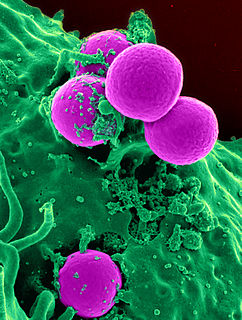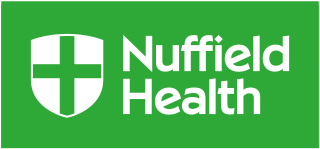
Methicillin-resistant Staphylococcus aureus (MRSA) refers to a group of Gram-positive bacteria that are genetically distinct from other strains of Staphylococcus aureus. MRSA is responsible for several difficult-to-treat infections in humans. MRSA is any strain of S. aureus that has developed or acquired a multiple drug resistance to beta-lactam antibiotics. Beta-lactam (β-lactam) antibiotics are a broad-spectrum group that include some penams and cephems such as the cephalosporins. Strains unable to resist these antibiotics are classified as methicillin-susceptible S. aureus, or MSSA.

Klebsiella pneumoniae is a Gram-negative, non-motile, encapsulated, lactose-fermenting, facultative anaerobic, rod-shaped bacterium. It appears as a mucoid lactose fermenter on MacConkey agar.

A Hospital-acquired infection also known as a nosocomial infection -from the Greek words nosos, meaning disease, and komide, care-, is an infection that is acquired in a hospital or other health care facility. To emphasize both hospital and nonhospital settings, it is sometimes instead called a healthcare–associated infection. Such an infection can be acquired in hospital, nursing home, rehabilitation facility, outpatient clinic, diagnostic laboratory or other clinical settings. Infection is spread to the susceptible patient in the clinical setting by various means. Health care staff also spread infection, in addition to contaminated equipment, bed linens, or air droplets. The infection can originate from the outside environment, another infected patient, staff that may be infected, or in some cases, the source of the infection cannot be determined. In some cases the microorganism originates from the patient's own skin microbiota, becoming opportunistic after surgery or other procedures that compromise the protective skin barrier. Though the patient may have contracted the infection from their own skin, the infection is still considered nosocomial since it develops in the health care setting. An easy way to understand the term is that the infection tends to lack evidence that it was incubating, or present when the patient entered the healthcare setting, thus meaning it was acquired post-admission.

The American College of Cardiology (ACC), based in Washington, D.C., is a nonprofit medical association established in 1949. It bestows credentials upon cardiovascular specialists who meet its qualifications. Education is a core component of the college, which is also active in the formulation of health policy and the support of cardiovascular research.

A needlestick injury is the penetration of the skin by a hypodermic needle or other sharp object that has been in contact with blood, tissue or other body fluids before the exposure. Even though the acute physiological effects of a needlestick injury are generally negligible, these injuries can lead to transmission of blood-borne diseases, placing those exposed at increased risk of infection from disease causing pathogens, such as the hepatitis B virus (HBV), hepatitis C virus (HCV), and human immunodeficiency virus (HIV). Among healthcare workers and laboratory personnel worldwide, more than 25 blood-borne virus infections have been reported to have been caused by needlestick injuries. In addition to needlestick injuries, transmission of these viruses can also occur as a result of contamination of the mucous membranes, such as those of the eyes, with blood or body fluids, but needlestick injuries make up more than 80% of all percutaneous exposure incidents in the United States. Various other occupations are also at increased risk of needlestick injury, including law enforcement, laborers, tattoo artists, food preparers, and agricultural workers.
Infection prevention and control is the discipline concerned with preventing healthcare-associated infections; a practical rather than academic sub-discipline of epidemiology. In Northern Europe, infection prevention and control is expanded from healthcare into a component in public health, known as "infection protection". It is an essential part of the infrastructure of health care. Infection control and hospital epidemiology are akin to public health practice, practiced within the confines of a particular health-care delivery system rather than directed at society as a whole. Anti-infective agents include antibiotics, antibacterials, antifungals, antivirals and antiprotozoals.
A patient safety organization (PSO) is a group, institution, or association that improves medical care by reducing medical errors. Common functions of patient safety organizations are data collection and analysis, reporting, education, funding, and advocacy.
A health professional may provide health care treatment and advice based on formal training and experience. The field includes those who work as a physician, surgeon, physician assistant, pharmacist, pharmacy technician, medical assistant, nurse, physical therapist, occupational therapist, dentist, midwife, psychologist, psychiatrist or who perform services in allied health professions. A health professional may also be a public health or community health practitioner.
Environmental Health Officers are responsible for carrying out measures for protecting public health, including administering and enforcing legislation related to environmental health and providing support to minimize health and safety hazards. Environmental Health Officers keep our water, food, air, land, facilities and other environmental factors safe of health hazards, whether biological, chemical or physical. They also address the related factors that impact behaviours. Environmental Health Officers assess and control environmental factors that can potentially affect health, to prevent disease and create health-supportive environments. Environmental determinants of health play a major role in a community’s overall health and well-being, and thus Environmental Health Officers are essential in improving population health outcomes and reducing the burden of disease.

The National Healthcare Group (NHG) is a Singapore group of healthcare institutions. The group was formed in 2000 and operates several hospitals, national specialty centres, and polyclinics. Tan Tock Seng Hospital is the largest hospital in the group and serves as the flagship hospital for the cluster.
The Healthcare in Kazakhstan is a post-Soviet healthcare system under reform. Life expectancy at birth in Kazakhstan is 148th in the world, below most developed nations and some developing nations. It is below the average life expectancy for the European Union. The World Health Organization (WHO), in 2000, ranked the Kazakhstani healthcare system as the 64th in overall performance, and 135th by overall level of health.
Healthcare in Finland consists of a highly decentralized three-level publicly funded healthcare system and a much smaller private sector. Although the Ministry of Social Affairs and Health has the highest decision-making authority, the municipalities are responsible for providing healthcare to their residents.

Nuffield Health is the United Kingdom's largest healthcare charity. Established in 1957 the charity operates 31 Nuffield Health Hospitals and 111 Nuffield Health Fitness & Wellbeing Gyms.

In health care facilities, isolation represents one of several measures that can be taken to implement in infection control: the prevention of communicable diseases from being transmitted from a patient to other patients, health care workers, and visitors, or from outsiders to a particular patient. Various forms of isolation exist, in some of which contact procedures are modified, and others in which the patient is kept away from all other people. In a system devised, and periodically revised, by the U.S. Centers for Disease Control and Prevention (CDC), various levels of patient isolation comprise application of one or more formally described "precaution".
Yisrael Safeek is an American physician, author, and healthcare software company executive. For the past 29 years, Safeek occupied a wide spectrum of roles within the US healthcare system - doctor, medical director, hospital co-owner, Joint Commission surveyor, Malcolm Baldrige Board of Examiners, health system Chief Medical Officer, book author, speaker, and software developer. Safeek made the short list for United States Undersecretary of Health. In 2010, he founded The SafeCare Group, a healthcare software firm with headquarters in Lexington, Kentucky with the motto of "Innovating Disrupting Transforming" healthcare. Before founding The SafeCare Group, Safeek served in the dual roles as system Chief Quality Officer of Covenant Health System and at the time the largest health system between Dallas and Los Angeles, and first Chief Medical Officer of the second largest clinical integration program in the US, Health Partners. As Covenant, Safeek accelerated the implementation of advanced clinical technologies, facilitated the adoption of evidence-based medicine,and reduced the overuse and misuse of clinical resources. The network aligned hundreds of independent physicians with the health system's goals and yielded tangible outcomes in patient safety, quality, and efficiency of care. Between 2005 and 2014, Safeek was employed by The Joint Commission holding certifications in the Hospital Accreditation Program (2005–2014), and the Outpatient-Based Surgery Program (2009–2014). In 2007, he was the first Kentucky physician appointed to the Board of Examiners for the Malcolm Baldrige National Quality Award program. Safeek is a diplomate Certified Physician Executive from the Certifying Commission in Medical Management, the American Board of Medical Specialties in Anesthesiology, and the National Board of Medical Examiners. He is a Vanguard Advisory Member of the American Association for Physician Leadership. and Fellow, the “highest honor awarded to physician leaders who have made significant contributions in improving the delivery and outcomes in medicine." In 2017, Safeek published a seven-point Making American Healthcare Great Again strategy. For each policy initiative, there was an outline of the Scope of the Problem; Policy Priorities; Deployment Phases; Special Considerations; and Accountability. A copy of the document was sent to President Trump at the White House.
The International Society for Infectious Diseases (ISID), established in 1986, is a nonprofit organization that works to control infectious disease outbreaks and improve the care of patients afflicted with these conditions.
An infection rate is the probability or risk of an infection in a population. It is used to measure the frequency of occurrence of new instances of infection within a population during a specific time period.
The Association of Occupational Health Professionals in Healthcare (AOHP) is a professional association focusing on the health, safety, and well-being of health professionals. It is the only national professional organization in the United States with the exclusive mission of addressing the needs and concerns of occupational health professionals in healthcare settings.

The COVID-19 pandemic has impacted healthcare workers physically and psychologically. Healthcare workers are more vulnerable to COVID-19 infection than the general population due to frequent contact with infected individuals. Healthcare workers have been required to work under stressful conditions without proper protective equipment, and make difficult decisions involving ethical implications. Health and social systems across the globe are struggling to cope. The situation is especially challenging in humanitarian, fragile and low-income country contexts, where health and social systems are already weak. Services to provide sexual and reproductive health care risk being sidelined, which will lead to higher maternal mortality and morbidity.

Elaine Lucille Larson is an American infectious disease specialist. As a Professor of Epidemiology at the Columbia University Mailman School of Public Health, she has published four books and more than four hundred articles on the subjects of infection prevention and control, disease epidemiology, and related issues. In 2017, Larson was named a "Living Legend" by the American Academy of Nursing, the Academy's highest honor.









